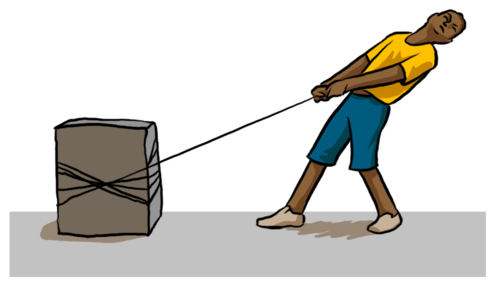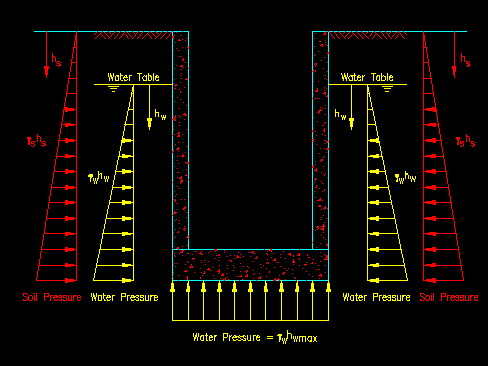Force and Stresses in Civil Engineering
Edited by Chameleon, Jen Moreau, Sharingknowledge, SarMal
Force is defined as the interaction that results in the movement, relocation or changes of an object. A force may tend to move or stop or modify the speed of motion of an object. There are many types of forces:
- Gravitational Force,
- Electrical Force,
- Magnetic Force,
- Applied Force.
The Earth attracts everything towards its center of gravity. This attraction is known as Gravitational Force. The closer an object is to the earth the more it will be attracted to it. A body with mass "m" attracts towards the land with acceleration due to gravity "g," and then weight "W".
So we can say the weight of a body is also a force. Force is not only the pushing and pulling, there are several ways of force application. When force is applied distributes termed pressure or stress.
There are practical examples of force and the behavior of an object moving against the force.
- 1 Tension Force and Stresses
- 2 Compression Force and Stresses
- 3 Circumferential or Hoop Stresses
- 4 Flexure Force and Stresses
- 5 Shear Force and Stresses
- 6 Punching Force and Stresses
- 7 Torsion Force and Stresses
- 8 Lateral Force and Stresses
- 9 Frictional Force and Stresses
- 10 Referencing this Article
- 11 Comments
Tension Force and Stresses
When we try to pull or drag an object with a rope, the rope stretches. An object that is hung with wire elongates the wire. This stretching and elongating force is tension. Cable bridges, truss members, and spring object are designed using tension. The tension force is normal or perpendicular to the cross-sectional area.
Compression Force and Stresses
Given that the molecules of a solid are packed closely, there is very little to no chance of further compaction. Compression force acts in two ways, either by crushing the body or bending it. Concrete is a mixture of fine and coarse aggregate that can undergo compaction which is why it is good at compression. If the load is more than the capacity of concrete, it will crush.
Circumferential or Hoop Stresses
Hoop stresses are due to the flow of fluids. Hoop stresses are tangential to the circumference. Water, oil, and drainage pipelines are designed for their thickness and can resist circumferential stresses.
Flexure Force and Stresses
When a heavy mass is laid on a floor, it will try to sag. If this load continues for an extended time, it may cause significant deflection. Building floors, beams, and the deck of bridges are designed to resist this flexural stress. IT is because of flexural bending that the top member undergoes compression while the bottom face observes tension. If it is a concrete material that is good at compression and weak in tension, it is required reinforcement to the lower face is required.
Shear Force and Stresses
Shear means to cut. Shear forces try to cut the object from its support or joints. Initially, cracks develop which propagate continuously throughout the member depth, and it fractures. Since concrete is weak in resisting shear, steel rings or stirrups are provided at some distance so that it could prevent brittleness.
Punching Force and Stresses
Punching is somewhat similar to shearing. If you put the tip of your pen on a piece of paper, the force exerted on the paper by the pen tip is called a punching force. This punching force will try to make a hole in the paper. Similarly, pillars and columns exert force to punch the footing and slab. Punching can be controlled by increasing thickness and improving strength of materials.
Torsion Force and Stresses
A force that tries to twist an object is called torsion force. If an object is free, this will cause rotation. If the object is fixed or supported, this force will cause it to bend around its own axis. Torsion is due to non-symmetry or irregularity. For example when you hang a dress on a hanger improperly, it will twist it due to torsion force.
Lateral Force and Stresses
The behavior of lateral force is flexural bending, but load distribution is not necessarily uniform. The wall of an aquarium is designed to resist water pressure or soil pressure if it is underground. This pressure distribution is not uniform. It increases with the depth and the maximum pressure is at the bottom of the wall. Similarly, an earthquakes load is the maximum at the lowest level while the wind is opposite of it. The top of most floors in a building will face maximum wind pressure.
Frictional Force and Stresses
The friction force is the force of resistance. Roads and pavements are designed to prevent skids and control acceleration.
Referencing this Article
If you need to reference this article in your work, you can copy-paste the following depending on your required format:
APA (American Psychological Association)
Force and Stresses in Civil Engineering. (2017). In ScienceAid. Retrieved Apr 26, 2024, from https://scienceaid.net/Force_and_Stresses_in_Civil_Engineering
MLA (Modern Language Association) "Force and Stresses in Civil Engineering." ScienceAid, scienceaid.net/Force_and_Stresses_in_Civil_Engineering Accessed 26 Apr 2024.
Chicago / Turabian ScienceAid.net. "Force and Stresses in Civil Engineering." Accessed Apr 26, 2024. https://scienceaid.net/Force_and_Stresses_in_Civil_Engineering.
If you have problems with any of the steps in this article, please ask a question for more help, or post in the comments section below.
Comments
Article Info
Categories : Engineering
Recent edits by: Sharingknowledge, Jen Moreau, Chameleon
























